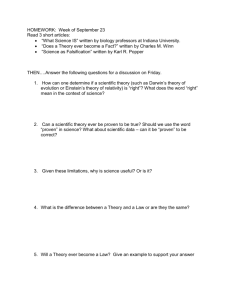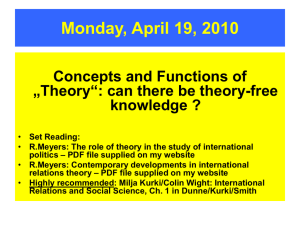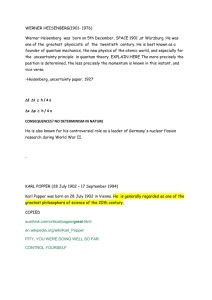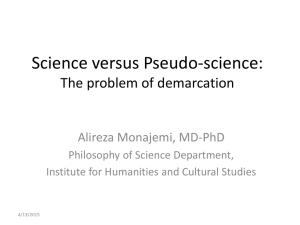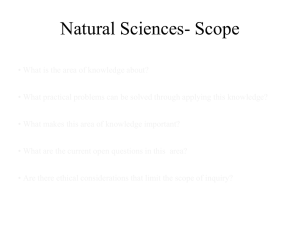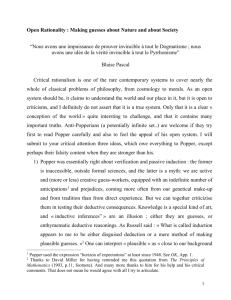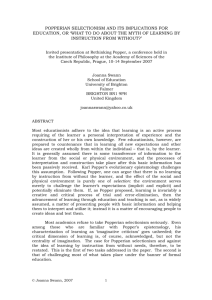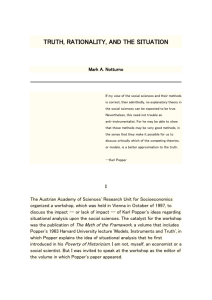Curricular Models References
advertisement
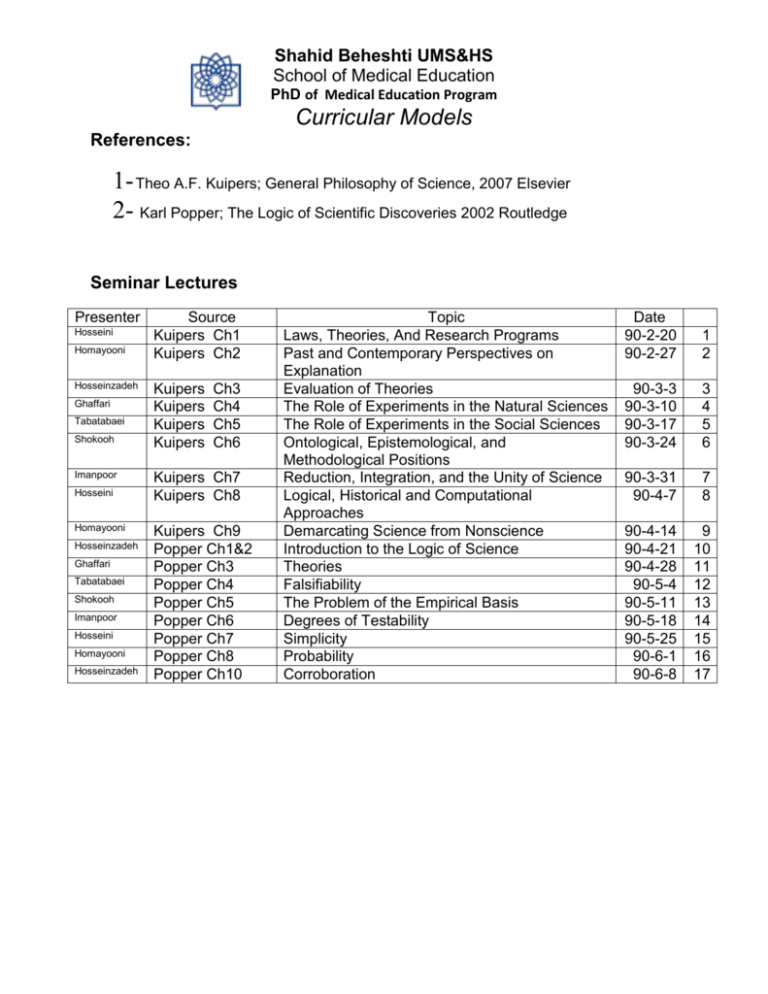
Shahid Beheshti UMS&HS School of Medical Education PhD of Medical Education Program Curricular Models References: 1- Theo A.F. Kuipers; General Philosophy of Science, 2007 Elsevier 2- Karl Popper; The Logic of Scientific Discoveries 2002 Routledge Seminar Lectures Presenter Hosseini Homayooni Hosseinzadeh Ghaffari Tabatabaei Shokooh Imanpoor Hosseini Homayooni Hosseinzadeh Ghaffari Tabatabaei Shokooh Imanpoor Hosseini Homayooni Hosseinzadeh Source Kuipers Ch1 Kuipers Ch2 Kuipers Kuipers Kuipers Kuipers Ch3 Ch4 Ch5 Ch6 Kuipers Ch7 Kuipers Ch8 Kuipers Ch9 Popper Ch1&2 Popper Ch3 Popper Ch4 Popper Ch5 Popper Ch6 Popper Ch7 Popper Ch8 Popper Ch10 Topic Laws, Theories, And Research Programs Past and Contemporary Perspectives on Explanation Evaluation of Theories The Role of Experiments in the Natural Sciences The Role of Experiments in the Social Sciences Ontological, Epistemological, and Methodological Positions Reduction, Integration, and the Unity of Science Logical, Historical and Computational Approaches Demarcating Science from Nonscience Introduction to the Logic of Science Theories Falsifiability The Problem of the Empirical Basis Degrees of Testability Simplicity Probability Corroboration Date 90-2-20 90-2-27 1 2 90-3-3 90-3-10 90-3-17 90-3-24 3 4 5 6 90-3-31 90-4-7 7 8 90-4-14 90-4-21 90-4-28 90-5-4 90-5-11 90-5-18 90-5-25 90-6-1 90-6-8 9 10 11 12 13 14 15 16 17 Shahid Beheshti UMS&HS School of Medical Education PhD of Medical Education Program Curricular Models Assignments Each article prepared for this course should have the same format: start with one page of main messages1; follow that with a three-page executive summary2; present your findings in no more than 25 pages of writing3. The articles should be written in Farsi. The due date for finishing articles is 90-6-1. The printed article, the MS Word file of the article on a CD, and PDF files of retrieved references on the same CD are the deliverables of the assignment. 1 2 3 4 5 6 7 Topic Causality and Causal Modeling in the Social Sciences Science and Values Science and Partial Truth Science, and order The Metaphysics of Science Theories of Scientific Progress Unifying Scientific Theories Students’ Name Hosseini Homayooni Hosseinzadeh Ghaffari Tabatabaei Shokooh Imanpoor Final Score: 1 Main Messages: They are the heart of your article, the lessons readers can take from your article. Don’t confuse them with a summary of findings: you have to go one step further and tell your audience what you think the findings mean for them. The messages, per se, may not even appear in the text. They are what can be inferred from your report. 2 Executive Summary: These are your findings condensed to serve the needs of the busy reader, who wants to know quickly whether the article will be useful. Start by outlining what issues you were looking at, sum up the answers you found. In executive summary the most interesting stuff goes at the top, followed by the background and context and less important information further down (newspaper-like sequence of content). This is not the place for more than a line or two about the approach, methods and other technical details. Concentrate on getting the essence of your article across succinctly but not cryptically. 3 The Report: There is a maximum of 25 pages of space for the complete report of your work. The general content of the report must includes following parts: Context: outline the issue or problem your article addresses. State the question clearly. Highlight other research and works. Implications: State what your findings mean for readers and decision makers. Note what different types of audiences may be interested in your work, and if the work has different messages for those different audiences, separate and label them. This is where the essence of your key messages is found. Approach: Outline your methods, including the search strategy, and the sources of information. Results: Summarize your findings to show how they support the conclusions you have presented, highlighting themes and messages. Use graphs and tables if they will improve understanding. Results that don’t relate directly to the conclusions shouldn’t be addressed. Additional Resources: Not for other researchers!, this is the place to give information on publications, web sites and other useful sources of information for readers and decision makers. References: References in the report should use consecutive superscript numbering and be presented as endnotes, not in the body of the text or the foot of the page. The references count as part of the report’s 25 pages. Shahid Beheshti UMS&HS School of Medical Education PhD of Medical Education Program Curricular Models Final Score is calculated from seminar lectures (10), article (6) and active class participation (4). Seminar Lecture Scores (10 points) 1 Complete Coverage of the topic4 2 Timeliness5 3 Scientific Mastery6 4 Structure7 5 Presentation skills8 6 Quality of PowerPoint Preparation9 20% 10% 40% 10% 10% 10% 2 1 4 1 1 1 Article Scores (6 points) 1 Complete Coverage of the Topic10 2 Scientific Integrity11 3 Structure12 4 Layout13 20% 50% 20% 10% 1.2 3 1.2 0.6 Active Class Participation Scores (4 points) 1 Orderly Class Attendance14 2 Participation in Class Discussions and Debates15 50% 50% 2 2 4 The Presentation Should Includes Complete Content of Corresponding Chapter Each Presentation Should Be Scheduled for a One Hour Lecture Followed By a Half an Hour Questions and Answers. 6 The Presenter Should Have Complete Mastery on The Topic of Presentation, and Could Answer Questions 7 Structured Flow of Content from Introduction to Closure 8 Effective Use of Voice, Appropriate Pace of Delivery, Interaction with Audience 9 Appropriate Font Size, Appropriate Content Per Slide, Appropriate Number of Slides, Appropriate Background, Appropriate Animations 10 Students Should Perform an Original Search around Their Topics Besides Covering The Content of The Given Assignment Reference Books. 5 11 Meaningful Abstraction, Omission of Trivia, Scientific Synthesis, Logical Conclusion The Articles’ Format Should Include The Pre-mentioned Parts of Main Messages, Executive Summary, and The Report (Context, Implications, Approach, Results, Additional Resources, and References). 13 Single-spaced with 12-point Arial Type Font and 2.5 cm Margins 12 14 The Presenter Should Attend The Class 15 Minutes before Presentation, and Other Students Should be in Class 5 Minutes before Class Time 15 Previous Study of The Topic, Purposeful Questions, Fruitful Discussions, Scientific Critics

